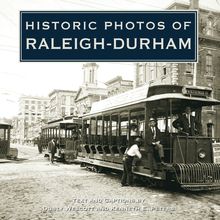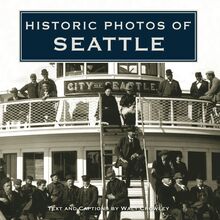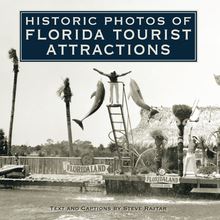Historic Photos of Corpus Christi , livre ebook
164
pages
English
Ebooks
2008
Vous pourrez modifier la taille du texte de cet ouvrage
Obtenez un accès à la bibliothèque pour le consulter en ligne En savoir plus
Découvre YouScribe en t'inscrivant gratuitement
Découvre YouScribe en t'inscrivant gratuitement
164
pages
English
Ebooks
2008
Vous pourrez modifier la taille du texte de cet ouvrage
Obtenez un accès à la bibliothèque pour le consulter en ligne En savoir plus
Publié par
Date de parution
21 mars 2008
Nombre de lectures
0
EAN13
9781618586186
Langue
English
Poids de l'ouvrage
17 Mo
Corpus Christi, Texas, is one of the most pristine coastal cities on the Gulf of Mexico. Once a simple nineteenth-century trading post at the mouth of the Nueces River, this port city has survived war and hurricanes on its road to becoming an important meat-processing, petroleum, and commercial center.
Historic Photos of Corpus Christi captures the richness of this unique coastal city in nearly 200 black-and-white archival photographs. Author Cecilia Gutierrez Venable, a Corpus Christi-area historian, transports the reader through the past of the "Sparkling City by the Sea” in a journey that will not soon be forgotten.
Publié par
Date de parution
21 mars 2008
Nombre de lectures
0
EAN13
9781618586186
Langue
English
Poids de l'ouvrage
17 Mo
HISTORIC PHOTOS OF
CORPUS CHRISTI
T EXT AND C APTIONS BY C ECILIA G UTIERREZ V ENABLE
This view from North Broadway Street on the bluff, looking toward the bay, features Market Hall. This building served as a place for vendors. Graduation exercises, parties, and other recreational activities were held on its second floor. The narrow building on the left was used as City Hall. Across the street is the Watts and Dunne school supplies shop.
HISTORIC PHOTOS OF
CORPUS CHRISTI
Turner Publishing Company
200 4th Avenue North Suite 950
Nashville, Tennessee 37219
(615) 255-2665
www.turnerpublishing.com
Copyright 2008 Turner Publishing Company
Historic Photos of Corpus Christi
All rights reserved.
This book or any part thereof may not be reproduced or transmitted in any form or by any means, electronic or mechanical, including photocopying, recording, or by any information storage and retrieval system, without permission in writing from the publisher.
Library of Congress Control Number: 2007941389
ISBN-13: 978-1-59652-428-6
Printed in the United States of America
08 09 10 11 12 13 14 15-0 9 8 7 6 5 4 3 2 1
C ONTENTS
A CKNOWLEDGMENTS
P REFACE
S EAPORT T OWN T HROUGH THE G ILDED A GE (1840-1893)
P ROGRESSIVE E RA (1894-1925)
T HE M AKING OF A M ODERN C ITY (1926-1939)
W AR Y EARS AND A FTERMATH (1940-1949)
T HE G ROWING M ETROPOLIS (1950-1969)
N OTES ON THE P HOTOGRAPHS
Employees of the Harrison Coffee Company stand behind the counter of the coffee shop around 1910. This store opened by 1904 and was known as the Harrison s Coffee and Tea Store, which advertised the Lowest prices on Coffees, Teas, and Fancy Groceries.
A CKNOWLEDGMENTS
This book resulted from the cooperation and aid from many institutions and individuals. The vision, dedication, and hard work the Corpus Christi Public Libraries has invested in its collection made possible a large majority of the photographs for this publication. The library director, Herb Canales, along with Laura Garcia, Gerlinda Riojas, and Norma Gonzalez were invaluable resources. Thanks also to Rebecca Jones for her work on the photographs.
Texas A M University-Corpus Christi Special Collections and Archives donated several images for this publication, and a special thanks to Grace Charles, who was indispensable in finding images. The input of Dr. Thomas Kreneck, Jan Weaver, and Mike Rowell were much appreciated.
The Library of Congress also provided images from its extensive holdings.
The expertise of local historians Bill and Marjorie Walraven, Anita Eisenhower, and Murphy Givens was also important in the completion of this work.
Finally, I would like to thank Audrey Flores for her dedication in getting this book together. Her hard work and perseverance were greatly appreciated. The patience and understanding of my husband, James C. (Jake) Venable, and daughter, Breanna Venable, were immeasurable.
P REFACE
At a little over a century old, Corpus Christi is a relatively young city. However, the land it rests on is thousands of years old. Through glacial formation and thaws which affected sea level change, as well as sedimentation and deposition from rivers, the land and bay emerged to form an ideal area for a port town. One of the first Native tribes to explore the Gulf Coast was the Karankawa Indians. Although nomadic, they did follow game and searched for mollusks, fish, and berries in the area. Several European expeditions landed on these shores as early as the late sixteenth century but established few permanent settlements. It would take the foresight of an ambitious entrepreneur to plant the seed for the city s development.
Henry L. Kinney arrived near Corpus Christi in 1839, fleeing from scandalous affairs and failed business dealings. This charismatic fortune hunter sought to profit from outfitting troops and found this area to be conducive to such efforts. Always a profiteer, Kinney tended to favor whoever provided the best deal. When Zachary Taylor s troops camped in the area in 1845, many people passed through town, but few stayed. In order to entice settlers to this area, Kinney held one of the first state fairs, but this scheme also failed to attract new residents. However, by 1854 Corpus Christi did have schools, churches, a strong organization for women, and fraternal lodges. When the yellow fever struck later that year, many citizens perished, but Kinney remained optimistic about the city s growth and continued to advertise the area s attributes to the Northern states and European countries. When the Civil War began, Kinney fled to Mexico in search of another pot of gold. However, he did not count on the two bullets that pierced his body when he attempted to have a rendezvous with an attached woman. He died that night in 1862.
The Civil War continued to disrupt this area. In 1863, Union forces blockaded the bay and pummeled the city with shot and shell on several occasions. At the end of the war, the town experienced a surge in population, mainly because of the cattle and sheep business. These goods could be processed and shipped to other parts of the country. When the railroad arrived around 1875, shipping, industry, and numerous businesses flocked here, along with several boosters-in particular, Elihu H. Ropes. He wanted to deepen the port, and he marketed the area as the Chicago of the Southwest, but his dreams fell through with the Panic of 1893. He passed away during a trip to solicit Northern investors.
Despite Ropes failure, the city grew and attracted additional railroads that promoted the area in hopes of increasing the number of people who used their rails. As more tourists and new residents entered the area, additional hotels, houses, and businesses were needed to accommodate the growing city. However, many of these new structures and entities would be destroyed in 1919 by one of the most devastating hurricanes ever to hit the area. Hundreds of people died in the disaster, and many of the buildings were washed away. The city would not recover from this economic loss for at least seven years.
The Corpus Christi port, which opened on the seventh anniversary of the hurricane-September 14, 1926-spurred growth dramatically and transformed the town into a modern city. In less than ten years after the opening of the port the population doubled, new office buildings dotted the city s landscape, and larger hotels made their home here. By the 1930s, the oil industry was an important part of the economy and cushioned the devastating effects of the Great Depression. The city s population again doubled and continued on an upward trend with the arrival of the Naval Air Station in 1941. After World War II, the oil and gas industry again boosted the economy with further development of refineries. The port also increased its capabilities and handled various exports including cotton, grains, petroleum products, crude petroleum, and natural gas. Tourism also continued to be a boon for the area and brought in many businesses.
This book captures this city s development through a montage of photographs depicting the history of the area, its people and events. No changes have been made except for touching up imperfections caused by the damage of time and cropping where necessary. The focus and clarity of many images is limited to the technology of the day and the skill of the photographer who captured them.
This project represents the sifting of thousands of photographs. Many hours of research were expended in an attempt to achieve a well-balanced view of the city s life. The only limit to this endeavor was the lack of existing images from certain segments of history. In this book, the reader is encouraged to view Corpus Christi through the lens of the past and, in doing so, perhaps gain a deeper understanding of what the city is today and where it is going.
The pipe hauled to the King Ranch for artesian wells filled most of this commercial intersection of Chaparral and Peoples streets on this 1890s day. Several businesses are also pictured, including the W. S. Rankin Grocery Store; C. C. National Bank; E. H. Caldwell s Hardware Store; Randolph Robertson s Well Machinery shop; Western Union office; and a two-story building which held a store at the street level and a hall for dancing or skating on the second floor.
S EAPORT T OWN T HROUGH THE G ILDED A GE
(1840-1893)
A visitor reported in the 1840s that Corpus Christi consisted of only five stores and a grog shop. The Mexican-American War proved a boon to local businesses. Zachary Taylor and his troops arrived in 1845, the year before the war began, and departed in 1846, but progress continued. The Corpus Christi Gazette soon began publication. Although short-lived, it provided the groundwork for subsequent newspapers. Corpus Christi received its first post office, and the following year the town was placed in Nueces County as the county seat. By 1852, the city incorporated with B. F. Neal as mayor. Soon, a jail and courthouse joined a growing number of homes and businesses.
The Civil War temporarily curtailed growth as Federal ships blockaded trade and briefly bombarded the city in 1862. Commerce resumed soon after the war, but a yellow fever epidemic in 1867 decimated about a third of Corpus Christi s citizens. Four years later, the city acquired a fire department and the Sisters of the Incarnate Word opened their doors to aid children. In 1874, this port city watched as a steamship docked near town, traveling down the newly dredged channel. A little over ten years would pass before additional tracks were laid for the San Antonio Aransas Pass Railroad.
Like Kinney in the early decades of the nineteenth century, the railroad attempted to market this area, encouraging commerce and tourists. However, the master of boosterism was Elihu Harrison Ropes, who arrived in Corpus Christi in 1888. He dredged channels, developed subdivisions, built a fabulous hotel, and marketed the area to Nort














